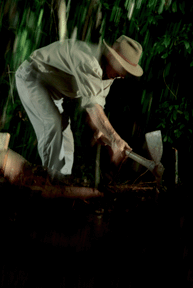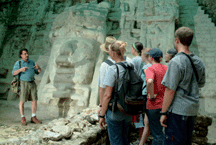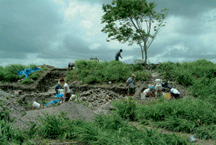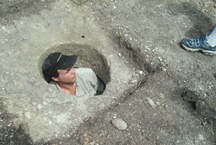|
Lost empires, Forgotten kings
TCU
students with the Maya Research Program are helping unearth ancient Maya
civilization -- one trowel full of dirt at a time.
By Nancy
Bartosek

 Incense
probably perfumed the air as the Mayan king gathered his elite one somber
day in 500 A.D. As they stood around the posthole used to hoist their
banner high over the temple, a priest bent down and carefully interred
two clay vessels. Laden with treasures of the kingdom, the pots crowned
the offering that filled the 10-foot, stone-lined shaft in layers of dirt
and jade. The people were on the cusp of war; these 1,500 pieces of precious
jewelry, dedicated to their god, was insurance against loss. Incense
probably perfumed the air as the Mayan king gathered his elite one somber
day in 500 A.D. As they stood around the posthole used to hoist their
banner high over the temple, a priest bent down and carefully interred
two clay vessels. Laden with treasures of the kingdom, the pots crowned
the offering that filled the 10-foot, stone-lined shaft in layers of dirt
and jade. The people were on the cusp of war; these 1,500 pieces of precious
jewelry, dedicated to their god, was insurance against loss.
The city
of about 20,000 had become a hub of prosperity at the junction of two
major rivers in what is now western Belize. Because of its wealth, war
with the neighbors was probably inevitable. But this was a war they could
not afford to lose. For 1,000 years this kingdom had thrived on an escarpment
overlooking the waterways that connected the coastal zone with the rich
agricultural interior. The offering they made that fateful day indicates
they had no intention on letting others take control.
No one knows
what happened, but it appears that the war was indeed lost and the royal
family, which had been in power 400 years, was forced out.
In another
300 years the civilization collapsed, possibly due to climate changes
that destroyed the agricultural base, and the once heavily-settled region
emptied as people moved to the coast.
***
It was the
end of the final day of the 1995 excavation season for archeologists with
the Maya Research Program (MRP), and most of the group had returned to
camp to pack. Suddenly one of them stumbled on a plaster surface hidden
under a stair step.
"We had no
idea what we had found," recalls TCU anthropology Professor Thomas Guderjan,
founder and president of the MRP. "We actually thought, 'Crud, we're going
to have to come back tomorrow to take notes before we leave.' "
But curiosity
got the best of them. They lifted the plaster and stared, dumfounded.
There sat two intact pots. One contained 365 pieces of jade. The other
housed a rare, tubular slab of jade and another 30 pieces of jewelry.
Eight years
later, Guderjan's eyes shine at the memory. "The feeling?" he said, shaking
his head. "I can't describe the feeling."
The group
had just unearthed the third largest jade cache ever discovered in Mayan
ruins. The archeologists stayed two more weeks to finish the excavation.
And they're
still unearthing the city's secrets today.
If Belize
on Central America's east coast seems off the beaten path, then Blue Creek
in the northwest corner of the country even further defines remote. The
village rests quietly at the end of a 40-mile stretch of sparsely inhabited
gravel road, parts of which are barely passable in the rainy season. Settled
by German-speaking Mennonites in the 1950s, the tidy farming community
is the summer home of the nonprofit Maya Research Program, which Guderjan
started in 1992 after discovering the ancient city tucked among the farms
there.
Today, the
Blue Creek site is the flagship of the MRP, which has expanded to include
several other archeological and anthropological projects. What was once
a tent camp has become a full-fledged research facility that can house
and feed up to 60 people as they excavate sites in the area.
Modeled after
Earthwatch, which furthers scientific endeavors through volunteers in
150 countries, MRP uses students and others to help fund the program,
as well as provide the copious man-hours demanded of an excavation season.
The volunteers get unexcelled experience in the field; the program gets
its research goals accomplished.
But participating
in an MRP dig is not for the faint-hearted. Nor is it a vacation. The
volunteers spend a minimum of two weeks with the dirt, the sweat, the
bugs and the occasional poisonous snake. They sleep in small metal caba–as
and rise with the sun. After a quick meal they head to the jungle, or
maybe a barren hilltop in the hot Belizean sun, to scrape out trowels
full of dirt as they meticulously unearth ancient structures. This truly
is working in the trenches.
 Yet
the volunteers come back year after year. Jared Fuller, a senior anthropology
and RTVF double major from Aledo, found the experience so rewarding professionally
and culturally -- "last year they were teaching us Mayan words and
songs," he said, pointing to two local men on the top of a mound
struggling with a tree root -- that he dedicated a second summer vacation
to MRP this year. Yet
the volunteers come back year after year. Jared Fuller, a senior anthropology
and RTVF double major from Aledo, found the experience so rewarding professionally
and culturally -- "last year they were teaching us Mayan words and
songs," he said, pointing to two local men on the top of a mound
struggling with a tree root -- that he dedicated a second summer vacation
to MRP this year.
Fuller hopes
to combine his majors into a career producing documentaries about projects
like Blue Creek.
"There's
this cliche about what this work is like," he said as he paused between
shovels of dirt. "But it's a lot different than you think. You can talk
about these things all you want in a class, but you will never really
get the feel of it."
"Nope," added
Kirsten Davis, an ad/PR and anthropology double major from Kingwood, Mass.
"It gives you a really different view of what anthropology is all about.
You can't get driving-on-a-muddy-dirt-road-in-the-back-of-a-truck in a
book. It's really made me realize what they go through to get this knowledge."
Davis speaks
from experience. The day before, the group took a trip to Lamanai (La'
ma nye), a site about 40 miles away that the Belize government is restoring.
The students bumped there over a battered road in the back of a small
pickup. In the pouring rain.
"Archeology
and anthropology in general have completely changed my direction, my perception
of what I want to be," she said, noting that she's applying now for graduate
school. "I want to do sociological and culture studies and make comparisons
of historical and contemporary anthropology."
Davis spent
six weeks in the field this summer. After a month-long stint digging,
she lived among the ancestors of the ancient Maya in Yaxunah (Ya' shu
na), a traditional Mayan community in the Mexican state of Yucatan. This
ethnographic field school on the lives of contemporary Maya, headed by
TCU anthropology Professor Grace Bascope, is one of MRP's new programs.
Until now,
MRP field opportunities were limited to Blue Creek. But this summer the
TCU students started their trip at Ichpaatun (Ish' pa tune), an ancient
walled city on the coast near Chetumal in Mexico, where they surveyed
the site and began preliminary excavations of several buildings.
Traveling
next to Blue Creek, they learned about that site, as well as others nearby.
Their last week found them in Honduras and Guatemala, where they visited
Tikal and many other Mayan locations.
Altogether
they visited 22 sites -- one just a small cave where archeologists were
excavating charcoal flecks. At each stop they learned how that community
fit into the bigger story.
"We saw everything
from major restorations to very small sites known only to archeologists,"
Guderjan said. "And since they [the students and volunteers] had now participated
in this work, they understood what really goes into it."
Stitched
together, the month-long effort is designed to provide a rich educational
experience. Students earn six course credits. 
"Since we
do work with volunteers and students, it's crucial for us to provide them
with good resources, a good environment and good food," Guderjan said.
"If you look at these types of programs elsewhere, the students are often
going through a meat market and don't get much out of it. They're just
labor."
The program
also serves as a collaboration that trains professional and amateur archeologists.
Blue Creek is a field project for more than a dozen archeological specialists
around the country, and they drop in during the season to do their work.
Once there, they teach as well as conduct research.
There's
a soil analyst from Georgetown University, a professor from the University
of Kansas who studies microscopic plant remains called phytoliths in burial
caches, a Boston University pottery analyst, a stone tool expert from
Texas A&M, a doctoral candidate from Illinois University who studies ancient
architecture, even an archeological illustrator from the University of
Sussex in England.
"The students
couldn't get this sort of expertise at one university," Guderjan said.
"Here they have 12 specialists coming in to talk to them about their field.
It's a very intensive experience."
Bringing
that knowledge to life while the students sit in the dirt is a challenge.
But one the professors excel at, said Ramy Gorkowski '03, an Ad/PR major
from Wyoming. She sees the professors in a different light now -- not
just as teachers, but as friends.
"They are
this vast resource of knowledge," she said, her voice filled with enthusiasm.
"We get a lecture every other night and it's fun. They're always questioning
one another, always posing new ideas and possibilities based on what they
find each day."
With journals
to keep and reading to be done, lectures to attend and of course daily
excavations to conduct, the work can be exhausting, but no one complains.
The mood is upbeat, even as the workers fill water jugs and don hats to
head out for a long day of hard labor.
A searing
sun blazes relentlessly on the backs of the team at the Rosita site, a
grass-covered hill where one lone tree stands sentinel on a large mound.
It's the loftiest spot around, with an inspiring view of the rolling topography.
Knocking on Heaven's Door by the rock group Guns N' Roses blares
from a portable CD player, and several of the students are singing along.
"What's important
in archeology is a good CD," Fuller said, wiping the sweat from his face
with his shirt.
"Otherwise
you're just sittin' in the dirt," chimed in Meghan Dennis, a finance and
anthropology senior from Florida.
They both
laugh. They are sitting in the dirt. Shoveling the dirt. Sifting the dirt
through large framed screens to ensure no small artifact is missed.
And they
insist that they're having fun. It's hard to dispute when you hear the
back-and-forth banter.
It's hot
on this hill, though. Very hot. A blue plastic tarp fashioned into a makeshift
lean-to shades the lunch cooler. Occasionally the students rest. But mostly
they dig.
 In
the third week of excavation, the shape of the building is discernible.
Much of the front wall has been exposed. The field director carefully
documents the 40-meter wall on paper, drawing each stone and noting dimensions.
This large structure was likely a public building in an outlying area.
Maybe a government office. Other mounds within a rock's throw indicate
that it was part of a group of buildings, all facing a large courtyard. In
the third week of excavation, the shape of the building is discernible.
Much of the front wall has been exposed. The field director carefully
documents the 40-meter wall on paper, drawing each stone and noting dimensions.
This large structure was likely a public building in an outlying area.
Maybe a government office. Other mounds within a rock's throw indicate
that it was part of a group of buildings, all facing a large courtyard.
Excavating
a building follows a distinct pattern. First dig a trench through the
median of the structure to locate the front and back walls and any interior
rooms. If anything of value is buried in the building, it likely will
be in the center or at the center front wall.
Then drop
a trench along the outside of the front wall to determine the building's
length. This should also reveal any older structures beneath. Once you've
measured and mapped the building and removed all of the artifacts, refill
the trenches.
What? Fill
them back in?
"It maintains
the integrity of the structure," Guderjan said. "These buildings are not
going to be restored, so we don't want to leave them open to the elements.
Or the looters."
Only sites
with major tourist potential are restored. The work is costly and so must
have economic value. Most digs are like this site -- mundane and often
tedious, then reburied.
Twelve miles
to the west, another field director wields a large machete as the researchers
leave the road and head into the dense jungle. He whacks back low branches
and taps tentatively on every fallen tree before clambering over it. Just
yesterday one of the team nearly stepped on a large, highly poisonous
fer-de-lance snake coiled in a path. The machete is for just such
occasions.
The jungle
is sultry and dank. Sweat drips off eyebrows and drenches the thin cotton
clothing needed for such a climate. Light crawls through the thick canopy
in splinters and it takes a few moments for your eyes to adjust to the
dimness. The thick air presses on your chest and makes simple tasks like
walking in the tangled foliage even more difficult.
As the alien
screech of a howler monkey pierces the sodden atmosphere, you realize
the earthiness of the place surely played a part in the worship of the
land. The humidity envelops you, pressing you down into the musty soil
and vegetation, making you feel one with the earth.
But somehow,
being immersed in the elements of the ages connects you to the past.
At this site,
called Ixnoha (Ish' noh ha), the work involves three houses, none much
bigger than a storage shed by today's standards.
The small housing group sits near a medium-sized city center, which was
surveyed and mapped last season. But other than one large temple that
was looted over the winter, most of this site will keep its secrets.
Being here,
where history is ancient, has changed Katie Allerman forever.
"My passion
is the Mayans now," said the social work and anthropology senior. "This
research is much broader than I thought. We have an idea of what we are
going to find even before we start digging. People tend to think Indiana
Jones and adventure, but it's all very scientific and meticulous. And
when it all comes together, it all fits."
Pointing
at the mounds all around her, Allerman said she was surprised to discover
the scope of the civilization. Each mound was once a building.
"This was
a fully developed society with everything you'd find in a modern society,"
she said. "The political, social and economic structures become apparent
when you walk through the cities. When you study in a classroom, you're
left with the impression that the rulers ran everything. But it wasn't
that way at all. Even the lower classes had so much complexity.
"You know,
you work your butt off, but it is so rewarding. It's so hot and there
are so many bugs, but you really want to do it anyway."
No one knows
what the Maya called the city at Blue Creek. No one knows the name of
their first king, who was installed around 100 A.D. But much has been
determined in the 12 years since Guderjan and his MRP associates began
excavating the site.
Settled around
900 B.C., the community evolved into a major trade route. The residents
grew corn and beans and squash, which they bartered for jade and obsidian
and other goods from cities like Tikal and Copan.
In 100 A.D.,
the city was large enough to support a king, who installed himself in
a bloodletting ceremony involving more than 300 of the male population.
The dedicatory cache found by the MRP included 302 obsidian blades used
in such a ceremony. What seems barbaric now was sacred, a way to honor
and connect, through their blood, with their ancestors. Likely it was
also a symbol of allegiance to this new ruler by the leading citizens
of the community.
At its zenith,
the city included two temples that rose 50 feet, two large plazas, a palace
and a ball court, an indication of the city's status as a ceremonial center
for a large population.
In 500 A.D.,
there was that seminal event marked by the jade cache. And by 800 or 900
B.C., the area was abandoned.
Excavations,
which began with the city center in 1993, have moved into the outlying
areas like Ixnoha, where researchers study the city's support base. They're
looking at neighboring communities and what would have been suburbs to
the main city.
"The real
value in studying Blue Creek is linking it into the big picture about
the Maya," Guderjan said. "This was a small community that grew because
of its ability to trade what it produced. It was at a major strategic
location and became very wealthy. You can't really begin to understand
the greater Maya civilization without looking at the economics, and Blue
Creek is a particularly good example of that."
It's also
a great example of change and dynamism, another important facet in the
big picture. Yes, there was that jade offering, but the real treasure
at Blue Creek lies in the details: the food the Mayans grew, the pots
they cast, the tools they used, the very land they lived on.
Jon Lohse,
a research associate at UT Austin and project director at Blue Creek,
said the research has become a "holistic view of the region more than
a site-focused investigation." And yet it is from those small, seemingly
insignificant house groups and farm fields that evidence emerges for later
study.
"Most of
what we learn from a season's digging here we'll learn long after we go
home," Lohse said.
It all adds
to the broader archeological questions, such as Why did they abandon
their cities?
Blue Creek
has yielded one possibility already.
"We discovered
that a population expansion corresponded to more farming on the plain
below the escarpment," Lohse said. "In conjunction with that, we now know
that later there was a corresponding rise in the water table of several
inches during just one generation."
The drainage
ditches created the economic power on which to sustain public projects
like pyramid building. However, as crops began to rot when the water table
rose, the agricultural economy failed to sustain the elites and royals.
And eventually the community faded into history.
With the
MRP branching out to new areas, even more questions will be addressed.
The goal at coastal Ichpaatun, for example, is to examine the whole theme
of maritime trade and its effects.
"We've learned
a lot about the role of the peripheral regions in the larger state-level
society," Guderjan said. "These sites aren't Tikal or Chichen Itza, but
these people were integrated into that society. And we're learning how."
The famed
archeologist Walter Taylor once said there's no proof in pre-history.
Which makes archeology one of man's greatest puzzles.
"We
can make a model, but we can never prove it to be correct," Guderjan
said. "And that makes it one of the most intellectual challenges
I can think of." Maybe those elusive answers are what draw so many
to argue with snakes and heat and thousands of years of jungle growth.
"The
more questions I get answered, the more questions I have," Allerman
said. "When I go home, I'm never going to look at a hill the same
again."
For some
it's the hunt for that hidden treasure.
"I'm amazed
at how dense the artifacts are," said Eddie King, a speech communication
senior from Waco. "You just pick a spot and start digging, but you don't
even keep it all because there's so much stuff."
But maybe
it's even more. Maybe it's just the adventure of it all.
"Yesterday
we were on a hill and it was raining and the wind was blowing and we were
trying to eat our lunch with no cover," King said, grinning. "I felt like
was on an expedition to Patagonia or something.
"It makes
me feel tougher than dirt."
Contact
Guderjan at guderjan@tcu.edu. Comment on this story at tcumagazine@tcu.edu.

Modern
Maya
In the shadow
of an ancient Maya trading center, a modern study is underway in the town
of Yaxunah (Yah' shoe nah), Mexico. There, anthropology Instructor Grace
Bascope works with a Maya community of about 500, studying their way of
life and helping them adapt traditional ways to the modern world.
This year
Yaxunah came under the Maya Research Program's umbrella, and four TCU
student volunteers spent two weeks with Bascope and others, conducting
census interviews, mapping a nearby community and teaching the Yucatec/Spanish-speaking
villagers a third language -- English.
Bascope has
spent 12 years years in the community studying children's health issues
and assisting the residents in their own community-generated development
initiatives. She also helped them convert former archeological field camp
buildings into Campamento Yaxhuna, an eco-tourist hotel that is perhaps
the only one of its kind owned and operated totally by Maya. Two ruins,
the ancient Yaxunah site and the colonial hacienda Ketel-ak, are located
on the village communal lands.
This ethnographic
volunteer opportunity is the kind of work senior Marchelle Jordan wants
to spend a lifetime doing.
"I loved
it because of the people," she said, noting they are tenacious and loving
even while living in difficult circumstances. She would recommend the
experience to everyone.
"I think
seeing the world outside of yourself, outside of your perspective is important,"
she said. "It helps you see the world through a different pair of eyes."
Contact
Bascope at gbascope@airmail.net. Learn about the ecoturist hotel at Maya.csuhayward.edu/campamento/camp1.aspl

Top
|



